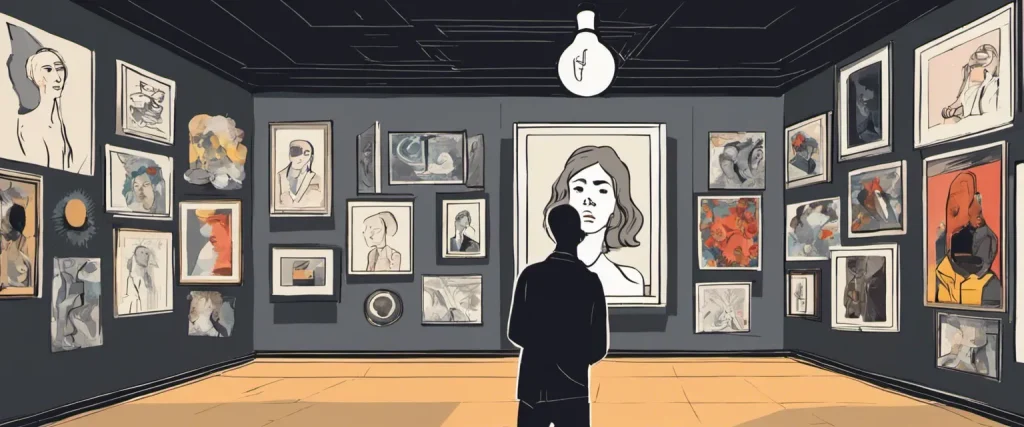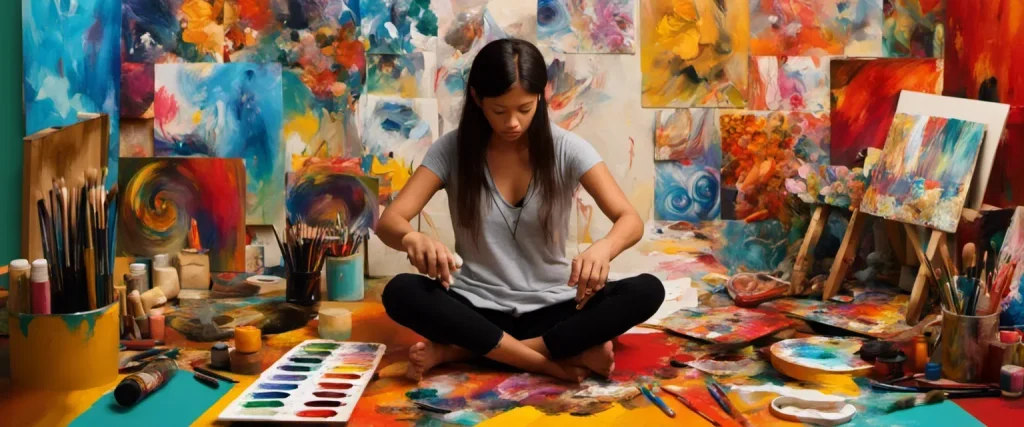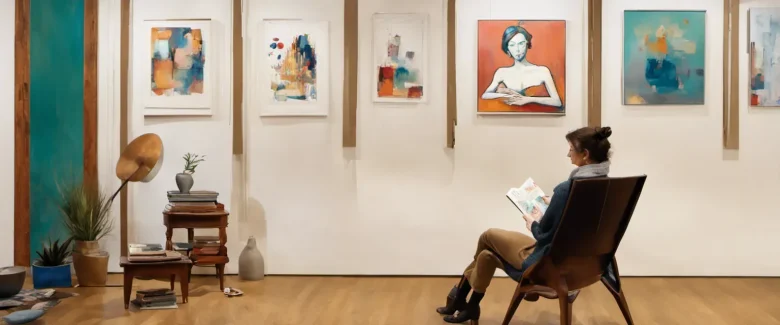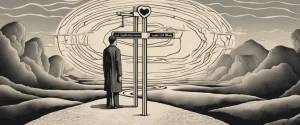In “Art as Therapy,” Alain de Botton explores the transformative power of art, offering a refreshing approach to appreciating and understanding its potential in our lives. By presenting a unique perspective on the purpose of art, De Botton unveils how it can function as a form of therapy, guiding us towards personal growth and emotional well-being. As an acclaimed philosopher, esteemed author, and founder of The School of Life, De Botton brings a wealth of knowledge and insight to the topic, making him a leading voice in the field of self-help and philosophy. His ability to connect complex philosophical ideas with everyday experiences makes his work accessible and relevant to a wide audience. Throughout “Art as Therapy,” De Botton invites readers to discover how art can serve as a powerful tool for self-reflection, empathy, connection, and ultimately, a source of profound personal fulfillment.
Chapter 1: Introduction – The Role of Art in Our Lives
In Chapter 1 of “Art as Therapy” by Alain de Botton, the author explores the role art can play in enhancing our lives and addressing our emotional needs. De Botton contends that art has the capacity to serve as a therapeutic tool, enabling us to find solace, inspiration, and introspection.
The chapter starts by emphasizing the limitations of traditional art appreciation, which often focuses on historical context, technical skill, and aesthetic appeal. De Botton argues that this approach overlooks the essential purpose of art: to cater to our emotional and psychological needs. He proposes a shift towards a more personal and subjective understanding of art, suggesting that we can engage with artworks by relating them to our own experiences and emotions.
De Botton highlights the potential for art to aid us in navigating the complexities of daily life. He states that art has the ability to alleviate sorrow, express our desires, and provide a remedy for our shortcomings and frustrations. For example, a painting of a solitary figure can help us feel understood in our moments of loneliness. By identifying with artworks, we can develop a deeper connection to our own emotions and vulnerabilities.
Furthermore, art can act as a form of therapy by allowing us to confront difficult emotions. De Botton states that art has the power to facilitate catharsis, enabling us to explore and process suppressed feelings in a safe and controlled environment. It encourages us to confront our fears, anxieties, and even our mortality.
In conclusion, this chapter emphasizes the transformative potential of art. By acknowledging and engaging with the emotional dimensions of artworks, we can use them as tools for self-reflection, solace, and personal growth. Art, when utilized thoughtfully, can enhance our lives and offer a means of therapy by connecting us to our deepest emotions and desires.
Chapter 2: Art as Solace and Comfort
Chapter 2 of “Art as Therapy” by Alain de Botton explores the idea that art holds immense potential to provide solace and comfort in various aspects of life. The chapter begins by discussing the fundamental human need for consolation, which arises from the challenges and pain we experience. According to de Botton, art can alleviate our suffering and offer solace by addressing our deepest human concerns.
The author divides our concerns into five categories: love, nature, money, politeness, and mortality. Through these topics, he shows how art can function as a therapeutic tool. For example, in the realm of love, art can help us navigate our complex emotions, find hope, or remind us of the universal experiences of heartbreak and longing.
Furthermore, art can provide comfort by helping us reconnect with nature. By depicting landscapes, still lifes, or animals, art can allow us to appreciate the beauty and tranquility of the natural world, providing respite from the chaos of modern life.
Regarding money, de Botton argues that art can offer solace by reminding us of life’s transcendent values beyond material wealth. It can encourage us to reflect on our real desires and needs, rather than being solely driven by consumerism.
Art also plays a role in guiding us through the complexities of social interactions. By teaching us empathy and giving insight into different cultures and perspectives, art helps us navigate the challenges of politeness and understanding.
Lastly, art provides solace with regards to mortality. It does so by allowing us to confront our own mortality and reflect on the meaning of life. Art can provide comfort and help us find meaning and purpose in a world that often overwhelms us with its transience.
In summary, Chapter 2 explores how art can be a powerful source of solace and comfort in various areas of human existence – love, nature, money, politeness, and mortality. By engaging with art, individuals can find solace in their struggles, gain insights, and find solace in the face of life’s difficulties.
Chapter 3: Art as Self-Understanding and Reflection
Chapter 3 of “Art as Therapy” by Alain de Botton focuses on the idea that art has the power to help individuals understand and reflect upon their own emotions and experiences. The chapter aims to highlight how art can provide us with insights into our inner selves and assist in personal growth and self-discovery.
De Botton argues that art should serve as a tool for self-understanding rather than just a form of entertainment. He suggests that the artworks we are attracted to or find particularly moving often mirror our own desires, fears, and struggles. By observing art, we can identify these emotions within ourselves and gain a deeper understanding of our inner workings.
The chapter emphasizes that art can act as a form of therapy. It suggests that individuals should actively seek out artworks that resonate with their personal situations and emotions, rather than passively consuming art without considering its impact. By engaging with art that addresses their specific concerns, individuals can find solace, inspiration, and a sense of connection with the artist and their shared human experiences.
Furthermore, de Botton suggests that art has the power to bridge the gap between our rational mind and our complex emotions. Art can communicate emotions and experiences that may be difficult to put into words, serving as a means of expression and catharsis. Through aesthetics, art can provide a language for our internal struggles and lead to a greater sense of self-awareness and emotional well-being.
Overall, Chapter 3 of “Art as Therapy” argues for the transformative potential of art in aiding personal introspection and as a valuable tool for self-understanding. By actively engaging with art, individuals can uncover hidden emotions, gain new perspectives, and find solace in shared human experiences.
Chapter 4: Art as Therapy for Relationships

Chapter 4 of “Art as Therapy” by Alain de Botton focuses on the role of art in improving relationships. The chapter delves into the idea that art can act as a therapy for our relationships by enhancing our ability to connect with others, fostering empathy, and addressing the challenges we face in our interactions.
De Botton argues that our relationships often suffer due to a lack of communication and misunderstandings. Art, he suggests, can help bridge these gaps through its ability to express emotions and thoughts that are otherwise difficult to articulate. By engaging with art, we can better understand our own emotions and communicate them more effectively to our partners, enabling deeper connections.
Moreover, de Botton emphasizes the importance of empathy in relationships and suggests that art can act as a catalyst for developing empathy. Art allows us to see the world through the eyes of others, offering different perspectives and shedding light on experiences that may be unfamiliar to us. By broadening our understanding and encouraging compassion, art helps us empathize with our partners and navigate conflicts more constructively.
Additionally, the chapter discusses how art can help us address the challenges that often arise in relationships, such as the fear of abandonment or the desire for control. By exploring art that depicts these themes, we can confront and reflect on our own fears and anxieties, leading to personal growth and improved relationships.
Overall, Chapter 4 of “Art as Therapy” suggests that art has the potential to be therapeutic for our relationships by allowing us to communicate, fostering empathy, and confronting our own emotional barriers. By engaging with art in a thoughtful and intentional way, we can cultivate healthier and more fulfilling connections with others.
Chapter 5: Art as a Tool for Education and Growth
Chapter 5 of “Art as Therapy” by Alain de Botton explores how art can be a powerful tool for education and personal growth. The chapter argues that art has the ability to teach us about ourselves and the world around us in ways that traditional education cannot.
The chapter begins by explaining that art has a unique capacity to communicate universal human emotions and experiences, allowing us to connect with others on a deep, empathetic level. Art enables us to understand and explore complex emotions, providing a platform for self-reflection and personal growth.
Artistic creations can also serve as educational tools, offering insights into historical, social, and cultural contexts. Paintings, sculptures, and other artworks can capture specific moments in time, offering a window into different periods and societies. By engaging with art, we can develop a richer understanding of history and expand our cultural knowledge.
Moreover, art can act as a therapy tool, offering solace, comfort, and guidance in times of emotional distress. The chapter highlights how specific artworks can address various aspects of human life, such as love, loss, and self-discovery. By engaging with art, individuals can find personal meaning and support, navigating through their own life challenges.
In conclusion, this chapter emphasizes that art goes beyond mere aesthetic pleasure; it provides us with educational opportunities, personal growth, and emotional healing. By actively engaging with art, we can gain profound insights into ourselves, others, and the world at large.
Chapter 6: Art as Inspiration and Transformation
Chapter 6 of “Art as Therapy” by Alain de Botton explores the transformative and inspiring power of art in our lives. The chapter delves into the idea that art can provide us with therapeutic experiences and serves various functions that are often unrecognized in the modern world.
De Botton begins by discussing how art can act as a vehicle for emotional education. By engaging with artworks that depict themes like love, melancholy, or vulnerability, we can learn to better understand and navigate our own emotions. Artworks have the ability to channel complex emotions and offer us a sense of connection and empathy.
Additionally, art has the capacity to provide us with moral and ethical guidance. It can challenge existing beliefs or offer new perspectives on life. By examining ethical dilemmas or questioning societal norms depicted in artworks, we can reflect on our own values and choices.
Art can also act as a source of inspiration, helping us to find beauty and meaning in our lives. De Botton explains that art has the ability to awaken dormant desires within us and encourage us to pursue our passions and dreams.
Furthermore, art has the power to heal and offer solace during difficult times. By encountering familiar themes of loss, grief, or loneliness in art, we are reminded that these emotions are universally experienced and can find validation and comfort through the art.
In summary, Chapter 6 of “Art as Therapy” explores the multifaceted role that art plays in our lives. It acts as a medium for emotional education, offers moral and ethical guidance, provides inspiration and healing, and helps us find beauty and meaning in our existence. Through engagement with art, we can transform and enrich our lives, as well as develop a deeper understanding of ourselves and the world around us.
Chapter 7: Art as a Medium for Addressing Social Issues
Chapter 7 of “Art as Therapy” by Alain de Botton explores the role of art as a medium for addressing social issues. The chapter argues that art has the power to engage individuals in meaningful discussions and shape societal values.
The chapter begins by highlighting how art can act as a catalyst for social change, prompting viewers to question prevailing norms and provoke critical thinking. Art has the ability to challenge established power structures and address issues such as inequality, discrimination, and political injustice. It offers a unique platform for marginalized voices to be heard and for societies to confront uncomfortable truths.
De Botton emphasizes the importance of art as a therapeutic tool. Through its emotional impact, art can elicit empathy and compassion, allowing individuals to connect with the experiences of others. Art becomes a means of fostering understanding and social cohesion, breaking down barriers between people and encouraging empathy towards those who may be different from ourselves.
The chapter also explores the idea of art as an agent of cultural critique. Through their work, artists often voice their dissent and provoke dialogue around cultural norms and values. Art can serve as a mirror to society, reflecting its triumphs, flaws, and contradictions. By challenging established narratives, art can stimulate conversations about complex social issues such as gender, race, and identity.
Overall, Chapter 7 highlights the profound impact art can have on addressing social issues. By stirring emotions, fostering empathy, and facilitating critical discourse, art serves as a powerful tool for societal transformation and progress.

Chapter 8: Conclusion – Living with Artful Intention
Chapter 8 of the book “Art as Therapy” by Alain de Botton, titled “Conclusion: Living with Artful Intention,” wraps up the exploration of how art can enhance our lives and provide us with guidance for personal fulfillment. De Botton asserts that art holds immense potential to address our emotional and psychological needs, playing a crucial role in helping us lead more meaningful and connected lives.
The chapter emphasizes the importance of intention and active engagement with art. It suggests that we should go beyond merely consuming art passively but actively use it as a tool for self-reflection, self-improvement, and personal growth. Art should be approached as a therapeutic agent that can assist us in recognizing our desires, fears, and values, enabling us to make positive changes in our lives.
Through carefully chosen and accessible examples, De Botton highlights different ways art can guide our intentions. He encourages us to utilize art through various lenses, such as art as a source of solace, inspiration, education, and as a tool for self-understanding. By engaging with art intentionally, we can navigate the complexities of our emotional lives, gain insight into our own experiences, and develop empathy towards the experiences of others.
The chapter concludes with the reminder that art has the power to transform our existence. It can guide us towards a more fulfilling life by addressing our cravings for belonging, offering hope, and helping us find solace amidst our struggles. Ultimately, De Botton suggests that by incorporating art into our everyday lives with intention and purpose, we can discover new perspectives, nurture our emotional well-being, and create a meaningful connection with the world around us.
After Reading
In conclusion, “Art as Therapy” by Alain de Botton explores the transformative power of art and its potential to help individuals find meaning, healing, and personal growth. The book argues that art should serve a practical purpose in our lives, addressing our fundamental emotional needs such as love, identity, and hope. Through numerous examples and insightful analyses, de Botton and his co-author John Armstrong demonstrate how art can enable us to better understand ourselves, connect with others, and navigate the challenges of daily existence. By encouraging a new approach to engaging with art – one that prioritizes its integration into our lives – the book proposes art as a form of therapy that can guide us towards a more fulfilling and enriched existence.
1. Social Intelligence” by Daniel Goleman: This insightful book explores the importance of social intelligence in our daily lives. Goleman delves into the neuroscience behind our interactions and provides valuable tools to enhance our relationships and emotional well-being.
2. “Many Lives, Many Masters” by Brian L. Weiss: In this profound exploration of past-life regression therapy, Dr. Brian Weiss shares captivating case studies that provide evidence of the existence of past lives. This book offers a fascinating perspective on the spiritual journey and the possibility of healing through uncovering our past experiences.
3. Think Like a Monk” by Jay Shetty: Inspired by ancient wisdom, Jay Shetty presents a practical guide to finding peace and purpose in our modern lives. Drawing from his experience as a monk, Shetty shares transformative techniques and valuable insights to help us navigate life with greater clarity, mindfulness, and resilience.
4. The Art of Loving” by Erich Fromm: Expanding on the idea that love is an art form, Erich Fromm delves into the complexities of love and explores its role in our personal and social lives. This classic book examines the different aspects of love, including self-love, brotherly love, and romantic love, providing profound insights into the dynamics of human relationships.
5. The Book of Joy” by Dalai Lama and Desmond Tutu, with Douglas Abrams: In this inspiring conversation between two spiritual leaders, the Dalai Lama and Archbishop Desmond Tutu, readers are guided towards lasting joy and fulfillment. By exploring the nature of happiness and sharing personal anecdotes, this book offers wisdom and practical advice on finding joy even amidst life’s challenges.
These five books cover a wide range of topics related to emotional intelligence, spiritual growth, love, and joy. By reading them in conjunction with “Art as Therapy” by Alain de Botton, you’ll gain a holistic understanding of art’s potential to enhance our emotional intelligence and overall well-being.



